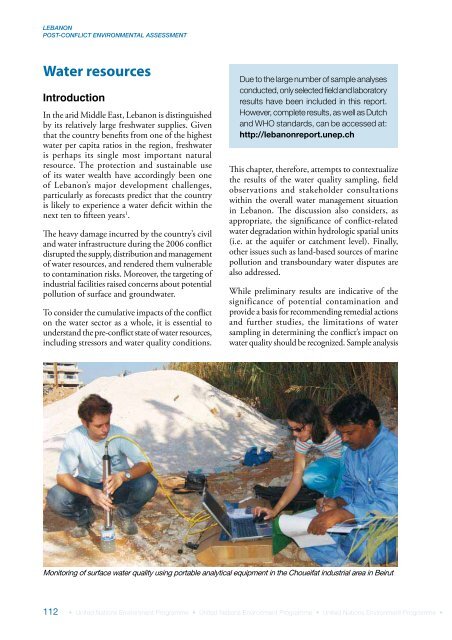Lebanon Post-Conflict Environmental Assessment - UNEP
Lebanon Post-Conflict Environmental Assessment - UNEP
Lebanon Post-Conflict Environmental Assessment - UNEP
Create successful ePaper yourself
Turn your PDF publications into a flip-book with our unique Google optimized e-Paper software.
LEBANONPOST-CONFLICT ENVIRONMENTAL ASSESSMENTWater resourcesIntroductionIn the arid Middle East, <strong>Lebanon</strong> is distinguishedby its relatively large freshwater supplies. Giventhat the country benefits from one of the highestwater per capita ratios in the region, freshwateris perhaps its single most important naturalresource. The protection and sustainable useof its water wealth have accordingly been oneof <strong>Lebanon</strong>’s major development challenges,particularly as forecasts predict that the countryis likely to experience a water deficit within thenext ten to fifteen years 1 .The heavy damage incurred by the country’s civiland water infrastructure during the 2006 conflictdisrupted the supply, distribution and managementof water resources, and rendered them vulnerableto contamination risks. Moreover, the targeting ofindustrial facilities raised concerns about potentialpollution of surface and groundwater.To consider the cumulative impacts of the conflicton the water sector as a whole, it is essential tounderstand the pre-conflict state of water resources,including stressors and water quality conditions.Due to the large number of sample analysesconducted, only selected field and laboratoryresults have been included in this report.However, complete results, as well as Dutchand WHO standards, can be accessed at:http://lebanonreport.unep.chThis chapter, therefore, attempts to contextualizethe results of the water quality sampling, fieldobservations and stakeholder consultationswithin the overall water management situationin <strong>Lebanon</strong>. The discussion also considers, asappropriate, the significance of conflict-relatedwater degradation within hydrologic spatial units(i.e. at the aquifer or catchment level). Finally,other issues such as land-based sources of marinepollution and transboundary water disputes arealso addressed.While preliminary results are indicative of thesignificance of potential contamination andprovide a basis for recommending remedial actionsand further studies, the limitations of watersampling in determining the conflict’s impact onwater quality should be recognized. Sample analysisMonitoring of surface water quality using portable analytical equipment in the Choueifat industrial area in Beirut112 • United Nations Environment Programme • United Nations Environment Programme • United Nations Environment Programme •
















